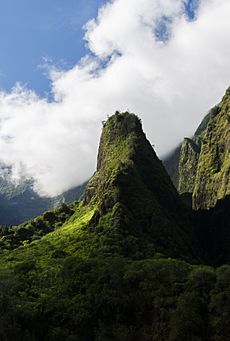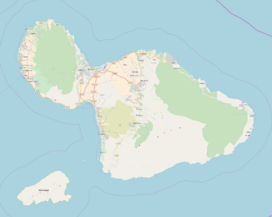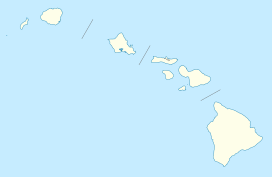Iao Valley facts for kids
Quick facts for kids ʻĪao Valley |
|
|---|---|
| ʻĪao Valley | |
 |
|
| Floor elevation | 1,000 feet (300 m) |
| Geography | |
| Designated | 1972 |
ʻĪao Valley is a beautiful, green valley found in West Maui, Hawaii. Its Hawaiian name, ʻĪao, means "cloud supreme" and is pronounced like "EE-yow." This valley is shaped by a stream and is located about 3 miles (5 km) west of Wailuku.
Because of its stunning nature and rich history, ʻĪao Valley is a popular spot for visitors. It was even named a National Natural Landmark in 1972, recognizing its special importance.
Contents
Discover ʻĪao Valley State Monument

The ʻĪao Valley State Monument is a state park covering about 6.2 acres (2.5 hectares). You can find it at the very end of ʻĪao Valley Road (Highway 32).
The Famous ʻĪao Needle
A famous landmark in the park is the ʻĪao Needle, also known as Kūkaʻemoku. This tall, green, rock formation is a leftover piece of lava. It rises an amazing 1,200 feet (366 meters) from the valley floor. That's taller than the Eiffel Tower!
The "needle" looks like a sharp spire when you see it from certain angles. It's actually part of the cliffs of the West Maui Mountains, which are from an old volcano. There's a short walking path called the ʻĪao Needle Lookout Trail. It leads to a windy viewpoint where you can see the Needle and the valley.
Explore the Rainforest of ʻĪao Valley
ʻĪao Valley is covered in a thick, green rainforest. Much of the forest on the valley floor has plants that were brought here from other places.
How Much Rain Does ʻĪao Valley Get?
The top of the valley, near the Puʻu Kukui summit, gets a huge amount of rain. It receives about 386 inches (9.8 meters) of rain each year! This makes it the second wettest place in Hawaii, just after The Big Bog. Most of this rain flows into the ʻĪao Stream, which runs through the valley. You can walk along trails in the State Park that follow this stream and go through the forest.
Native Cloud Forest and Wildlife
Higher up, above the ʻĪao valley, there's a special native cloud forest. This forest is home to native trees like ʻOhiʻa and Koa. Many native Hawaiian birds live here too, such as the ʻIʻiwi, ʻApapane, and ʻAmakihi.
A Look at ʻĪao Valley's History
ʻĪao Valley has a deep connection to Hawaiian beliefs and history.
Gods and Burial Grounds
In Hawaiian culture, the god Kāne is seen as the creator and giver of life. He is linked to fresh water, clouds, rain, and streams. Another Hawaiian god, Kanaloa, who is connected to the underworld, is represented by the stone of the ʻĪao Needle.
Long ago, Kapawa, a king of Hawaii, was buried here. Later, in the late 15th century, Maui's ruler Kakaʻe made ʻĪao Valley a special burial place for aliʻi (Hawaiian chiefs). Their remains were hidden in secret spots.
The Battle of Kepaniwai
In 1790, a very important event happened here: the Battle of Kepaniwai. During this battle, Kamehameha the Great fought against Kalanikūpule and the Maui army. Kamehameha was trying to unite all the Hawaiian islands. The battle was so fierce that the stream was said to be blocked by those who fell. Because of this, the battle site was named Kepaniwai, which means "the damming of the waters."
Kepaniwai Park and Heritage Gardens
Established in 1952, the Heritage Gardens at Kepaniwai Park celebrate the many different cultures that have shaped Maui. The gardens have special tributes and structures that honor the contributions of Hawaiian, American missionary, Chinese, Japanese, Portuguese, Korean, and Filipino cultures. The gardens were restored in 1994 after becoming overgrown.
Right next to the gardens, you'll find the Hawaii Nature Center. It has a museum and offers educational programs for children about Hawaii's nature and how to protect it.
See also
 In Spanish: Valle Iao para niños
In Spanish: Valle Iao para niños



